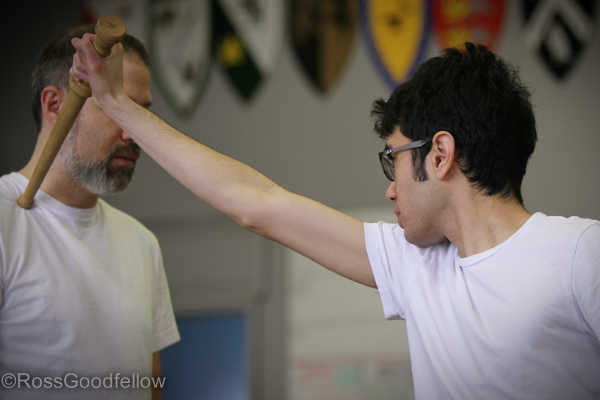Dagger (daga) 
A rondel or roundel was a type of stiff-bladed dagger in Europe in the late Middle Ages (from the 14th century onwards), used by a variety of people from merchants to knights. It was worn at the waist and might be used as a utility tool, or worn into battle or a jousting tournament as a side-arm. The blade was typically long and slim, measuring 12 inches (30 cm) or more; the whole dagger might be as long as 20 inches (50 cm). Rondel means round or circular; the dagger gets its name from its round (or similarly shaped, e.g. octagonal) hand guard and round or spherical pommel (knob on the end of the grip). [1]
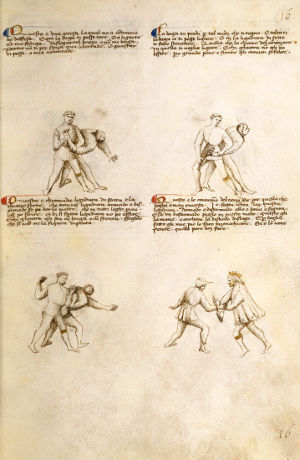
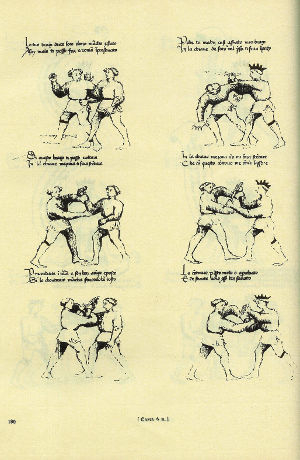
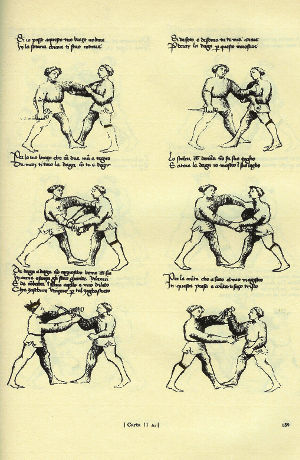
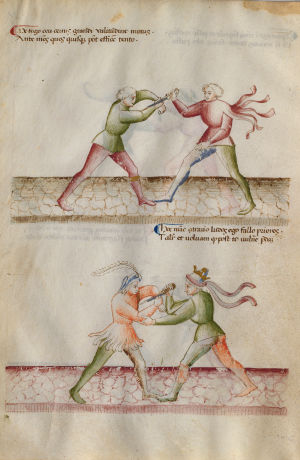
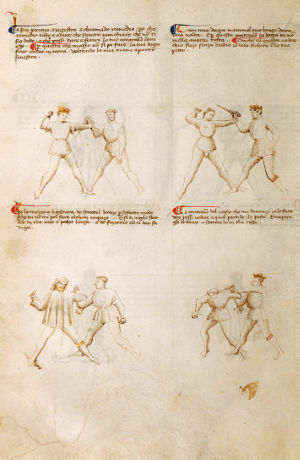
Dagger training involes two training units, the first which provides the student with the basics of dagger techniques in terms of off-line evading, re-direct and footwork followed by specific Liberi dagger techniques and plays. All of the techniques learned in training involves one dagger per pair, i.e. one person attacks with a dagger, the partner responds with an appropriate defensive/offensive maneuvre. Secondly, all techniques are learned from an unarmoured perspective. Both partners armed with daggers is reserved for scholler level of training. The fundamental combative principles learned during grappling or abrazare are leveraged into dagger training. This training is by no means complete with respect to dagger techniques, however, key elements are extracted from the 60+ dagger techniques and skills in order to enhance the overall experience and skill of the student and position the student to challenge for the prize of scholler, which if successful, is awarded a prize of a rondel dagger to signify achieving the scholler rank in the Academy.
Fiore dei Liberi [2] describes a system of training that included a large and intense section covering dagger combative techniques. He stresses that dagger techniques are leveraged from the earlier grappling (abrazare sections of his treatise which clearly indicates the importance of grappling in developing martial skills. His treatise contains numerous plates (illustrations) that depict variations on the theme of dagger play. Liber's treatise includes 13 plates depicting dagger vs. dagger, 63 plates depicting single dagger techniques, 9 plates depicting dagger and sword, 1 plate depicting dagger vs spear and 2 plates depicting dagger vs staff. What becomes clear during the dagger training is the fact that much of the abrazare fundamentals become obvious during dagger training and the student recognizes the connection between the abrazare and daga training. Liberi was clever in the manner of the structure of his treatise in which the skills learned in earlier sections are in fact leveraged in later sections. The success of his approach or "system" documented by Liberi is clearly the result of nearly 50 years of accumulated experience possessed by Liberi at the time of the writing of his treatise, which is one of the principle reasons that AEMMA has incorporated Liberi into its structured training program.
- A rondel dagger /ˈrɒndəl/ or roundel dagger was a type of stiff-bladed dagger in Europe in the late Middle Ages (from the 14th century onwards), used by a variety of people from merchants to knights. It was worn at the waist and might be used as a utility tool, or worn into battle or a jousting tournament as a side arm. The blade was made of steel, and was typically long and slim with a tapering needle point, measuring 12 inches (30 cm) or more; the whole dagger might be as long as 20 inches (50 cm). Rondel means round or circular; the dagger gets its name from its round (or similarly shaped, e.g. octagonal) hand guard and round or spherical pommel (knob on the end of the grip). source: Wikipedia. Rondel dagger. Retrieved: January 17, 2017.
- Fiore Furlano de Cividale d'Austria, delli Liberi da Premariacco (Fiore dei Liberi, Fiore Furlano, Fiore de Cividale d'Austria; born ca. 1350;[1] died after 1409[2]) was a late 14th century knight, diplomat, and itinerant fencing master. He is the earliest Italian master from whom we have an extant martial arts manual. His Flower of Battle (Fior di Battaglia, Flos Duellatorum) is among the oldest surviving fencing manuals. source: Wikipedia. Fiore dei Liberi. Retrieved: January 17, 2017.

